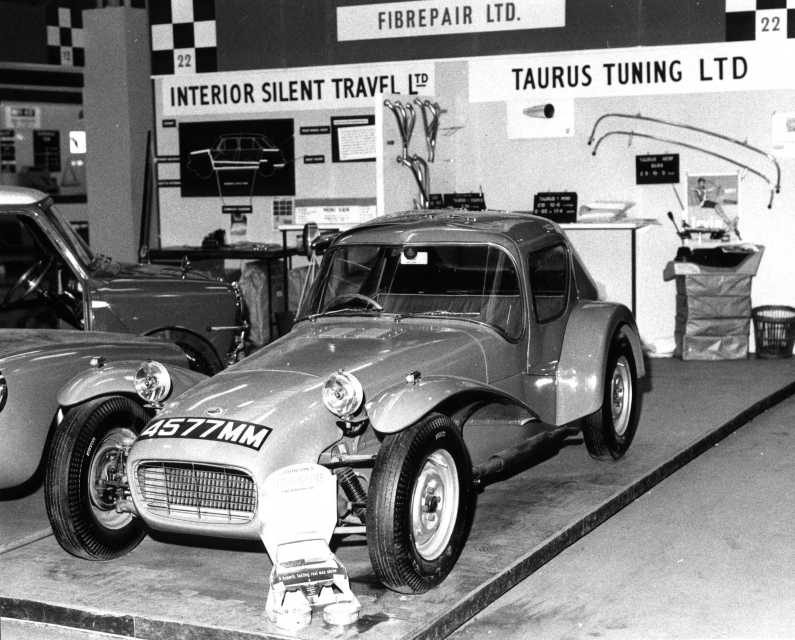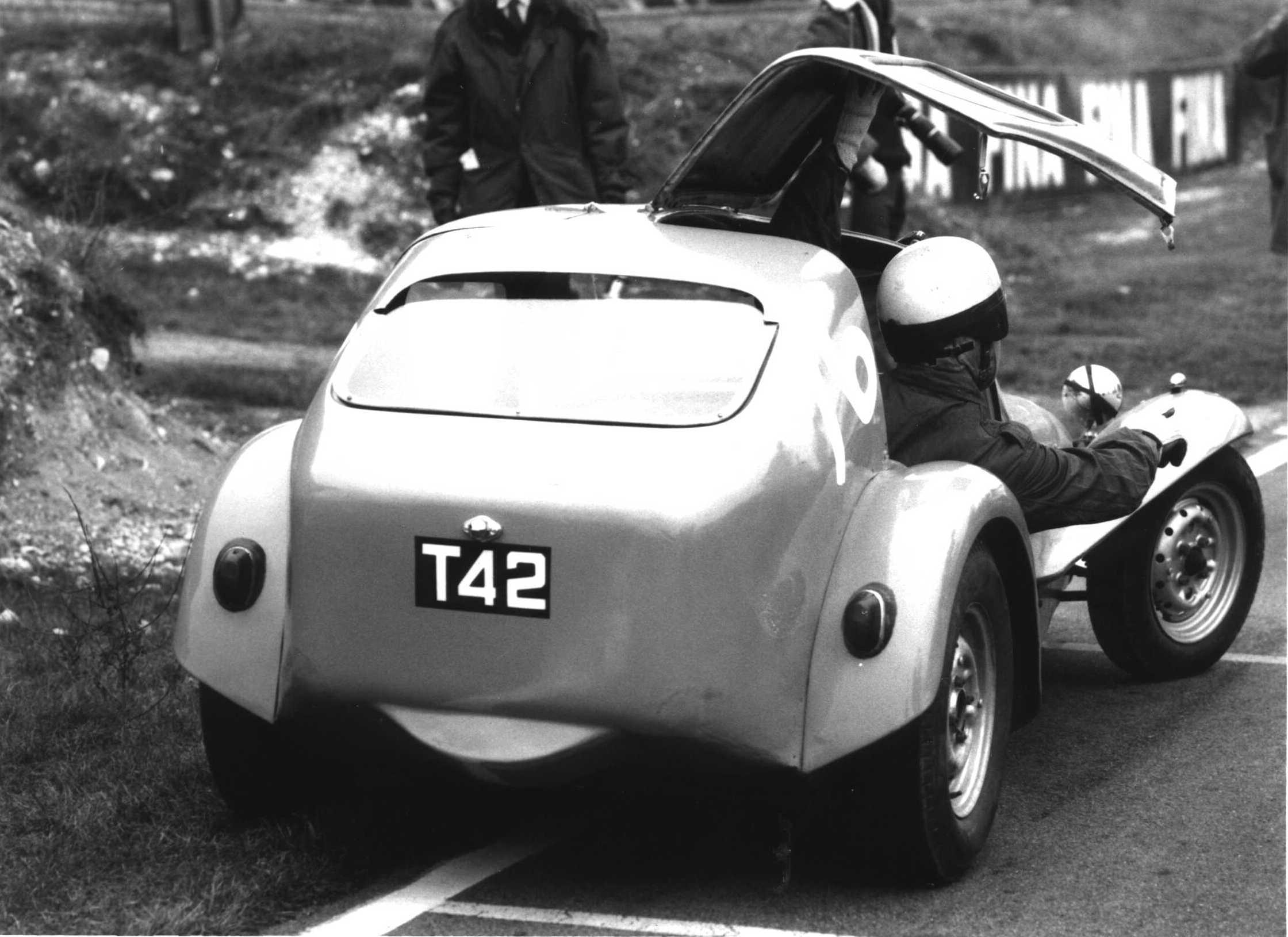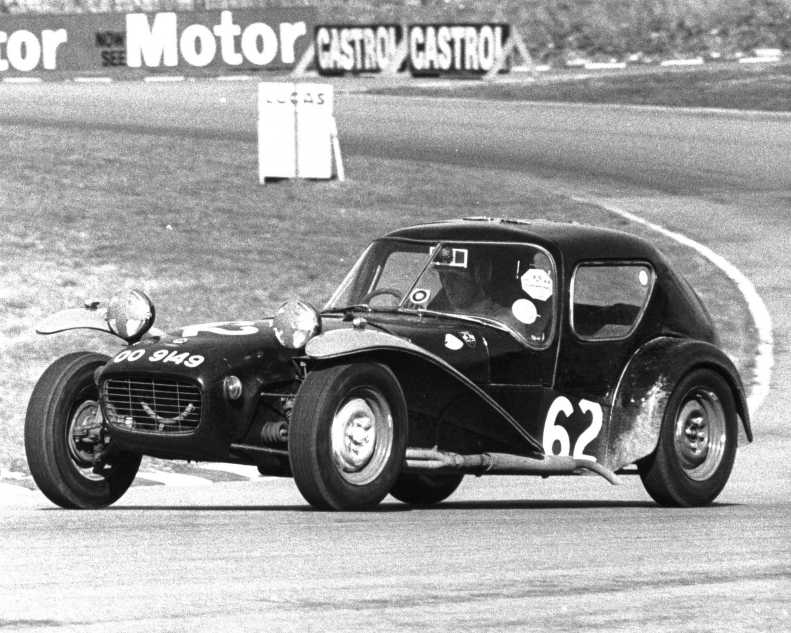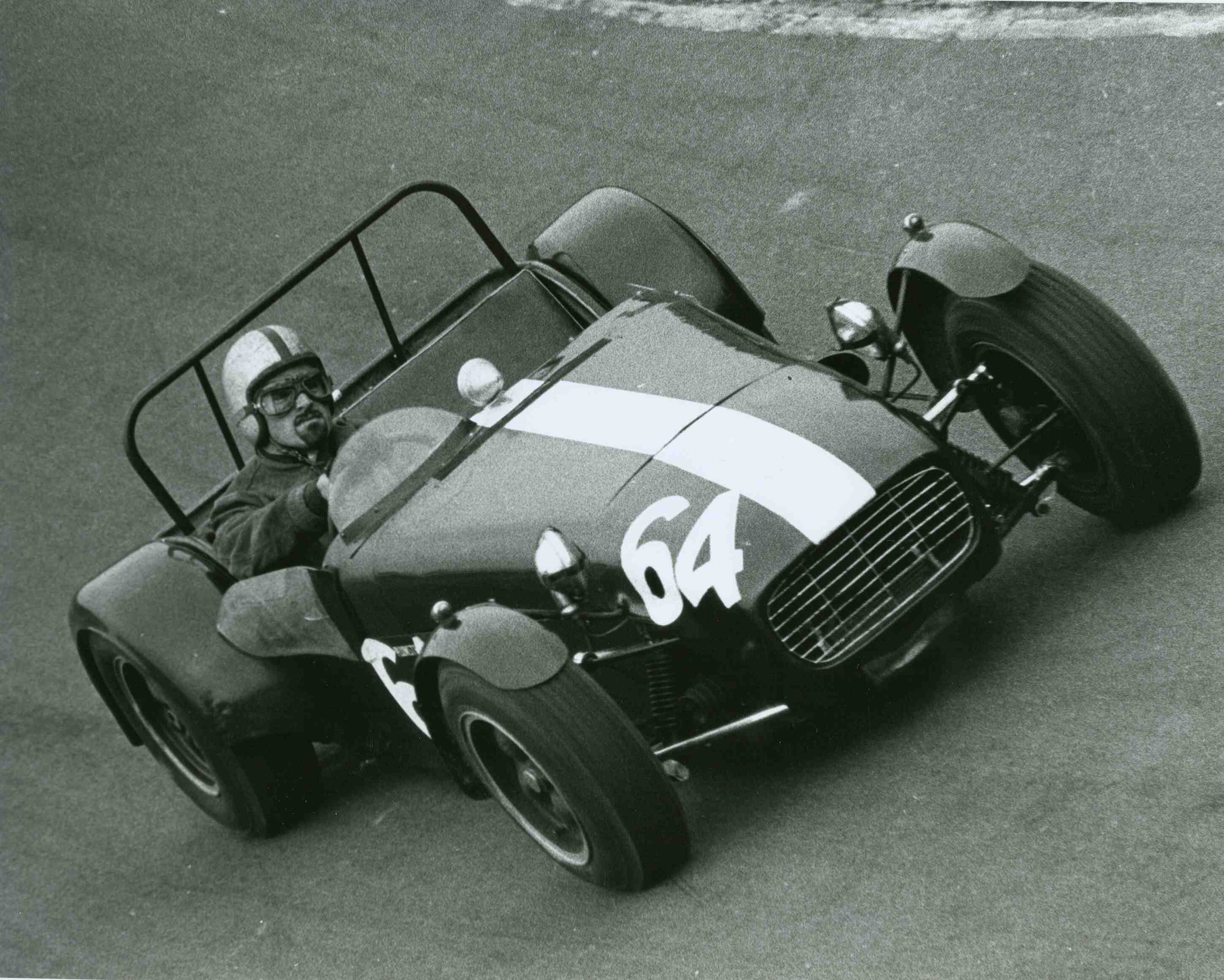 |
LOTUS SEVEN REGISTER |
 |
the web site for the
Seven made by Lotus between 1957 and 1973
~ The Lotus Seven
Story ~
Chapter Fourteen
The Series
2½, Special Series Two cars, Gullwing Hardtops and IRS.
THE SERIES 2½:
The car made
between mid-1968 and the end of the Series Two production in August 1968
became known as the Lotus Seven Series 2½. It was a transitional model and is
distinguished from the other Series Two cars having an air scoop on top of the
bonnet on the offside.
FORD’s NEW
CROSSFLOW POWER UNIT:
The new engine
was Ford’s 2255E 1600cc crossflow used in the Cortina 1600GT. It had overhead
valves like the previous non-crossflow unit, a 9.0:1 compression ratio, a
single Weber 32DFM twin choke progressive down-draught carburettor with
Coopers air cleaner and was in standard Ford Motor Company tune developing
84bhp at 5,500rpm. The gearbox, remote and gearknob was as for 116E engine.
Also available at the same time although very rare in a Seven was a similar
1300cc. unit developing 72bhp at 5,500rpm. The rest of the car remained the
same as the previous Series Two model using up the old Standard Ten axles with
4.1:1 crownwheel and pinion ratio and Triumph Herald wheels, thus unaltered
P.C.D.
NEW INTERIOR
FEATURES:
The last few
Series Two cars including any Series 2½ models may have been trimmed in black
in lieu of red.
PRODUCTION:
It is not clear
from the factory records how many Series 2½ cars were made, but as it was a
transitional model using up the old stock of parts, it is generally thought
that there were not many. Two crossflow engine options replaced the three non-crossflow
units that had been latterly available with the previous model: 105E (39bhp),
116E (66bhp) & 116E Cosworth (95bhp) now became 2255E 1600 (84bhp) and 2255E
1300 (72bhp) crossflows.
 1963 Racing Car Show Stand.
GULLWING
HARDTOPS:
By the early
1960’s competition in the Clubmans and Sportscar classes of racing had become
stiff indeed and as ever racers were looking for easy laurels. One way was
entry into the GT classes where cars tended to be heavier and therefore slower
for their engine size. Designed with competition in mind, Messrs Fibrepair
Limited of 21 Lancaster Mews, Paddington, W2 displayed their gullwing hardtop
called “The Seven GT” on Stand 22 at the Racing Car Show in January 1963.
Previously the aluminium prototype had raced at Boxing Day, Brands Hatch 1962
where it turned in the fastest practice time, although sadly sparking plug
failure had meant a d.n.f. in the actual race.
1963 Racing Car Show Stand.
GULLWING
HARDTOPS:
By the early
1960’s competition in the Clubmans and Sportscar classes of racing had become
stiff indeed and as ever racers were looking for easy laurels. One way was
entry into the GT classes where cars tended to be heavier and therefore slower
for their engine size. Designed with competition in mind, Messrs Fibrepair
Limited of 21 Lancaster Mews, Paddington, W2 displayed their gullwing hardtop
called “The Seven GT” on Stand 22 at the Racing Car Show in January 1963.
Previously the aluminium prototype had raced at Boxing Day, Brands Hatch 1962
where it turned in the fastest practice time, although sadly sparking plug
failure had meant a d.n.f. in the actual race.
 Seven GT Racing.
Fibrepair’s
“Seven GT” hardtop cost £77-0-0 supplied in kit form, but could be fitted to
your car by the suppliers in a day for an additional £10-0-0. In the event
only a few cars with these hardtops found their way onto the public roads as
the cockpit atmosphere was uncomfortable being, too hot because of lack of
ventilation, too noisy due to lack of sound insulation and a sound box effect
and too smelly due to engine and exhaust fumes and the smell of hot glass
fibre. More were fitted to competition Lotus Sevens, but sadly only a handful
of the few made survive today.
Seven GT Racing.
Fibrepair’s
“Seven GT” hardtop cost £77-0-0 supplied in kit form, but could be fitted to
your car by the suppliers in a day for an additional £10-0-0. In the event
only a few cars with these hardtops found their way onto the public roads as
the cockpit atmosphere was uncomfortable being, too hot because of lack of
ventilation, too noisy due to lack of sound insulation and a sound box effect
and too smelly due to engine and exhaust fumes and the smell of hot glass
fibre. More were fitted to competition Lotus Sevens, but sadly only a handful
of the few made survive today.
 The ex-Piers Courage Seven.
SEVEN REAR
SUSPENSION PROBLEMS:
As mentioned
previously, the first Lotus Seven, which Edward Lewis had piloted at The
Brighton Speed Trials in September 1957, was fitted with the de Dion rear
suspension from a Lotus Eleven. Except for those five special de Dion/Climax
Series One Sevens, all used well located, strong BMC axles. The Series Two
however had a weak axle located in a cost effective but unsatisfactory manner
which was a problem when increases in power and tyre performance came into
play. As they still do today, racers were always looking for answers to
problems and their successful solutions were readily copied by the
competition.
EARLY SEVEN IRS:
The first fully
independent rear suspension system was fitted to a Lotus Seven Series One in
1962. It was designed outside of factory hours by Lotus engineers Hugh Haskell
and Don Gadd, for a car owned by David Porter and Keith and Wendy Hamblin. It
utilised the differential from a Lotus Type 14 Elite and uprights and
universal joints from a Lotus 20 Formula Junior single seat race car. Whilst
other IRS Sevens followed in varying forms, they were always expensive
compared to the cost of beefing up a rigid axle and were prone to breakage as
well as having a high cost of maintenance. Only a few survive today.
THE LOTUS
THREE-7:
Lotuses two
stands at the January 1965 Racing Car Show at the Horticultural Halls, London
displayed five cars: A special Lotus Cortina with a BRM built Lotus Ford
twin-cam engine, a race version of a Lotus Elan S2, a Lotus 30 chassis with
engine exposed, a Lotus 35 Formula 2 car and the Lotus Three-7, a special car
designed for the new Clubman’s Formula. This new formula was intended as an
entry into circuit racing. Other cars competing included the Terrier and
Arthur Mallock’s U2. Lotuses ‘Three-7’ designation was coincidental to it
being the next in their type number order.
SPECIFICATION:
Improvements
over the ordinary Seven and Super Seven models include: Double wishbone front
suspension, fully independent Formula Junior type rear suspension with fixed
length drive shafts, disc brakes to all wheels with twin master cylinders
offering balance between front and rear, dry-sumped Cosworth-Ford Mark IX
1500cc engine developing 120bhp, light allow bellhousing and gearbox casing
and 13” x 6” lightweight magnesium alloy wobblyweb wheels with Dunlop R6
racing tyres.
A PROBLEM OF
COST:
At £1350-0-0 in
component form the new car was too expensive to attract any orders and the
show model remained the only example. After the show the car remained
languishing in a corner at the Cheshunt factory until it was prepared and
raced by Lotuses then Sales Director, John Berry who had some success in the
car. At the end of 1965 it was sold to Essex racer, Peter Deal, who
successfully campaigned it in 1966 Season.
The ex-Piers Courage Seven.
SEVEN REAR
SUSPENSION PROBLEMS:
As mentioned
previously, the first Lotus Seven, which Edward Lewis had piloted at The
Brighton Speed Trials in September 1957, was fitted with the de Dion rear
suspension from a Lotus Eleven. Except for those five special de Dion/Climax
Series One Sevens, all used well located, strong BMC axles. The Series Two
however had a weak axle located in a cost effective but unsatisfactory manner
which was a problem when increases in power and tyre performance came into
play. As they still do today, racers were always looking for answers to
problems and their successful solutions were readily copied by the
competition.
EARLY SEVEN IRS:
The first fully
independent rear suspension system was fitted to a Lotus Seven Series One in
1962. It was designed outside of factory hours by Lotus engineers Hugh Haskell
and Don Gadd, for a car owned by David Porter and Keith and Wendy Hamblin. It
utilised the differential from a Lotus Type 14 Elite and uprights and
universal joints from a Lotus 20 Formula Junior single seat race car. Whilst
other IRS Sevens followed in varying forms, they were always expensive
compared to the cost of beefing up a rigid axle and were prone to breakage as
well as having a high cost of maintenance. Only a few survive today.
THE LOTUS
THREE-7:
Lotuses two
stands at the January 1965 Racing Car Show at the Horticultural Halls, London
displayed five cars: A special Lotus Cortina with a BRM built Lotus Ford
twin-cam engine, a race version of a Lotus Elan S2, a Lotus 30 chassis with
engine exposed, a Lotus 35 Formula 2 car and the Lotus Three-7, a special car
designed for the new Clubman’s Formula. This new formula was intended as an
entry into circuit racing. Other cars competing included the Terrier and
Arthur Mallock’s U2. Lotuses ‘Three-7’ designation was coincidental to it
being the next in their type number order.
SPECIFICATION:
Improvements
over the ordinary Seven and Super Seven models include: Double wishbone front
suspension, fully independent Formula Junior type rear suspension with fixed
length drive shafts, disc brakes to all wheels with twin master cylinders
offering balance between front and rear, dry-sumped Cosworth-Ford Mark IX
1500cc engine developing 120bhp, light allow bellhousing and gearbox casing
and 13” x 6” lightweight magnesium alloy wobblyweb wheels with Dunlop R6
racing tyres.
A PROBLEM OF
COST:
At £1350-0-0 in
component form the new car was too expensive to attract any orders and the
show model remained the only example. After the show the car remained
languishing in a corner at the Cheshunt factory until it was prepared and
raced by Lotuses then Sales Director, John Berry who had some success in the
car. At the end of 1965 it was sold to Essex racer, Peter Deal, who
successfully campaigned it in 1966 Season.
 John Berry racing the Type 37 in 1965.
THREE YEARS
WITH TIM GOSS:
At the end of
1966 Tim Goss bought the car from Peter Deal for £1100-0-0. (Deal was going on
to Formula 3.) Tim had considerable success in 1967 achieving four wins, seven
seconds, sevens third places and seven lap records. He was runner-up in the
Clubmans Championship to Howard Heerey in a Chevron B1. During 1968 the engine
was bored out to 1600cc, Elan parallel link double wishbones were mounted onto
the spaceframe and wider wheels were fitted. Only one race was entered in that
year which was at Mallory Park where Tim won, but there was considerable
success at the Chamrousse International Hillclimb in the South of France with
eighth place overall and a class win and a class record.
John Berry racing the Type 37 in 1965.
THREE YEARS
WITH TIM GOSS:
At the end of
1966 Tim Goss bought the car from Peter Deal for £1100-0-0. (Deal was going on
to Formula 3.) Tim had considerable success in 1967 achieving four wins, seven
seconds, sevens third places and seven lap records. He was runner-up in the
Clubmans Championship to Howard Heerey in a Chevron B1. During 1968 the engine
was bored out to 1600cc, Elan parallel link double wishbones were mounted onto
the spaceframe and wider wheels were fitted. Only one race was entered in that
year which was at Mallory Park where Tim won, but there was considerable
success at the Chamrousse International Hillclimb in the South of France with
eighth place overall and a class win and a class record.
%20at%20Castle%20Combe%201967.jpg) The Type 37 when owned and raced by Tim Goss.
TOP HONOURS AT
LAST:
In 1969 Tim
found the money to do a full season again and won the big classes in the
Clubman’s Championship and the Lotus Seven Championship taking 14 wins, 3
seconds and 2 third places. In addition there was a repeat of the previous
years performance at Chamrousse with both a class win and new class record. At
the end of the year the car was sold to Peter Valdar whilst Tim went on to
campaign the Lotus 7X winning the Gregor Grant Clubmans Championship in the
1970 season.
POSTSCRIPT:
Valdar had
little success with the car and sold it in the same year to Ashley Devonshire
who restored it moving the engine back a la Mallock. Ashley went on to own the
car for over 30 years, selling it at auction in March 2001 for a hammer price
of £49,000. The new owner who paid £56,350 including buyer’s premium is
believed to live in Holland.
JWW
Coming next
Chapter 17:
Lotus Seven
Series Two Specification Synopsis.
Photographs
courtesy of:
Ferret
Fotographics
Tel:
01453-543243
Sources and
further reading:
Lotus Seven by
Jeremy Coulter (1986/1995)
The Type 37 when owned and raced by Tim Goss.
TOP HONOURS AT
LAST:
In 1969 Tim
found the money to do a full season again and won the big classes in the
Clubman’s Championship and the Lotus Seven Championship taking 14 wins, 3
seconds and 2 third places. In addition there was a repeat of the previous
years performance at Chamrousse with both a class win and new class record. At
the end of the year the car was sold to Peter Valdar whilst Tim went on to
campaign the Lotus 7X winning the Gregor Grant Clubmans Championship in the
1970 season.
POSTSCRIPT:
Valdar had
little success with the car and sold it in the same year to Ashley Devonshire
who restored it moving the engine back a la Mallock. Ashley went on to own the
car for over 30 years, selling it at auction in March 2001 for a hammer price
of £49,000. The new owner who paid £56,350 including buyer’s premium is
believed to live in Holland.
JWW
Coming next
Chapter 17:
Lotus Seven
Series Two Specification Synopsis.
Photographs
courtesy of:
Ferret
Fotographics
Tel:
01453-543243
Sources and
further reading:
Lotus Seven by
Jeremy Coulter (1986/1995)

 John Berry racing the Type 37 in 1965.
THREE YEARS
WITH TIM GOSS:
At the end of
1966 Tim Goss bought the car from Peter Deal for £1100-0-0. (Deal was going on
to Formula 3.) Tim had considerable success in 1967 achieving four wins, seven
seconds, sevens third places and seven lap records. He was runner-up in the
Clubmans Championship to Howard Heerey in a Chevron B1. During 1968 the engine
was bored out to 1600cc, Elan parallel link double wishbones were mounted onto
the spaceframe and wider wheels were fitted. Only one race was entered in that
year which was at Mallory Park where Tim won, but there was considerable
success at the Chamrousse International Hillclimb in the South of France with
eighth place overall and a class win and a class record.
John Berry racing the Type 37 in 1965.
THREE YEARS
WITH TIM GOSS:
At the end of
1966 Tim Goss bought the car from Peter Deal for £1100-0-0. (Deal was going on
to Formula 3.) Tim had considerable success in 1967 achieving four wins, seven
seconds, sevens third places and seven lap records. He was runner-up in the
Clubmans Championship to Howard Heerey in a Chevron B1. During 1968 the engine
was bored out to 1600cc, Elan parallel link double wishbones were mounted onto
the spaceframe and wider wheels were fitted. Only one race was entered in that
year which was at Mallory Park where Tim won, but there was considerable
success at the Chamrousse International Hillclimb in the South of France with
eighth place overall and a class win and a class record.
%20at%20Castle%20Combe%201967.jpg) The Type 37 when owned and raced by Tim Goss.
TOP HONOURS AT
LAST:
In 1969 Tim
found the money to do a full season again and won the big classes in the
Clubman’s Championship and the Lotus Seven Championship taking 14 wins, 3
seconds and 2 third places. In addition there was a repeat of the previous
years performance at Chamrousse with both a class win and new class record. At
the end of the year the car was sold to Peter Valdar whilst Tim went on to
campaign the Lotus 7X winning the Gregor Grant Clubmans Championship in the
1970 season.
POSTSCRIPT:
Valdar had
little success with the car and sold it in the same year to Ashley Devonshire
who restored it moving the engine back a la Mallock. Ashley went on to own the
car for over 30 years, selling it at auction in March 2001 for a hammer price
of £49,000. The new owner who paid £56,350 including buyer’s premium is
believed to live in Holland.
JWW
Coming next
Chapter 17:
Lotus Seven
Series Two Specification Synopsis.
Photographs
courtesy of:
Ferret
Fotographics
Tel:
01453-543243
Sources and
further reading:
Lotus Seven by
Jeremy Coulter (1986/1995)
The Type 37 when owned and raced by Tim Goss.
TOP HONOURS AT
LAST:
In 1969 Tim
found the money to do a full season again and won the big classes in the
Clubman’s Championship and the Lotus Seven Championship taking 14 wins, 3
seconds and 2 third places. In addition there was a repeat of the previous
years performance at Chamrousse with both a class win and new class record. At
the end of the year the car was sold to Peter Valdar whilst Tim went on to
campaign the Lotus 7X winning the Gregor Grant Clubmans Championship in the
1970 season.
POSTSCRIPT:
Valdar had
little success with the car and sold it in the same year to Ashley Devonshire
who restored it moving the engine back a la Mallock. Ashley went on to own the
car for over 30 years, selling it at auction in March 2001 for a hammer price
of £49,000. The new owner who paid £56,350 including buyer’s premium is
believed to live in Holland.
JWW
Coming next
Chapter 17:
Lotus Seven
Series Two Specification Synopsis.
Photographs
courtesy of:
Ferret
Fotographics
Tel:
01453-543243
Sources and
further reading:
Lotus Seven by
Jeremy Coulter (1986/1995)
